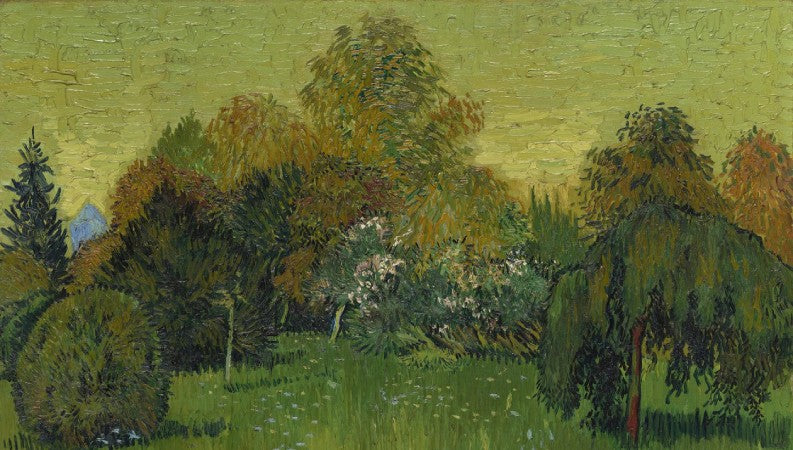
Van Gogh's Poet's Garden
Alice PettirossoShare
A Journey into the Light of the South: Summary and Context
In The Poet's Garden, Van Gogh captures the essence of a garden bathed in the light of the South of France , evoking his stay in Arles in 1888. Here, nature is not just a view but a reflection of his restless soul. The intense and vibrant colors express Van Gogh's deepest emotions. The intense green of the trees and grass merges with a bright yellow sky, creating a visual symphony that communicates both the vital energy of nature and the inner turmoil of the artist.
Nature in motion: the structure of the work
The painting is pervaded by a sense of movement. The trees seem to bend under the force of the wind and the flowers vibrate with a life of their own. The rapid and vivid brush strokes convey a sense of nature in continuous transformation. The shades of green blend and contrast with the intensity of the yellow sky, giving life to an almost surreal scene. Nothing is static: the garden is a place where life flows and renews itself continuously.
Brushstrokes like heartbeats: the painting technique
Van Gogh uses his signature technique of short, vigorous brush strokes , infusing the painting with a pulsating energy. The impasto technique enhances the three-dimensionality of the scene, making the colors emerge from the canvas. Here, the color is not intended to imitate reality, but to express the artist's state of mind. The intense yellow of the sky becomes a metaphor for his inner turmoil, while the shades of green and blue give depth to his vision of the natural world.
A Garden as a Refuge: Curiosities about the Work
Beneath the apparent calm of the garden lies a deep emotional restlessness. As in many other works by Van Gogh, nature becomes a refuge, a space where the artist seeks peace and order. The garden is not only a physical space, but a symbol of introspection, a place where Van Gogh takes refuge in moments of greatest tension. Nature becomes an anchor, a place of comfort.

PRE-ORDER A COPY FOR YOUR HOME
A World Beyond Reality: Comparisons and References
In the Poet's Garden, as in other works by Van Gogh, nature becomes a vehicle for expressing deep feelings. Similar to masterpieces such as Almond Blossom or Wheatfield with Crows , the garden goes beyond simple visual representation. Color, form and movement become tools to reflect the artist's soul. Van Gogh invites the observer to see beyond the surface, to explore the beauty and chaos that coexist in life.
Van Gogh and the representation of time in gardens
A lesser-known but equally fascinating aspect of Van Gogh's work is his ability to represent time. In The Poet's Garden, the artist captures the beauty of nature and the flow of time. The quick and nervous brush strokes do not outline a static landscape , but convey constant movement. Trees, flowers and grass go through different stages of life, suggesting that everything is in continuous evolution.
The garden as a metaphor for time
Every element of the painting seems to live a temporal cycle. The trees, with their shadows and curves, grow and bend under the weight of time, while the flowers vibrate, suspended between full bloom and decay. Van Gogh offers us a vision of the garden as a metaphor for life : everything is in perpetual movement, yet the artist tries to crystallize that moment of beauty. The sunlight, so predominant in the yellow sky, is not only a source of illumination, but also time itself that passes, illuminating everything and then vanishing.
A reflection of the fleeting nature of life
The poet's garden is not simply a landscape, but a reflection on time and the transience of life. Van Gogh's vibrant brush strokes capture the vital energy of a moment, with the awareness that it will escape. The garden, with its colors and its movement, becomes a symbol of the incessant cycle of life, a metaphor for existence itself and its continuous, inexorable process of transformation.
